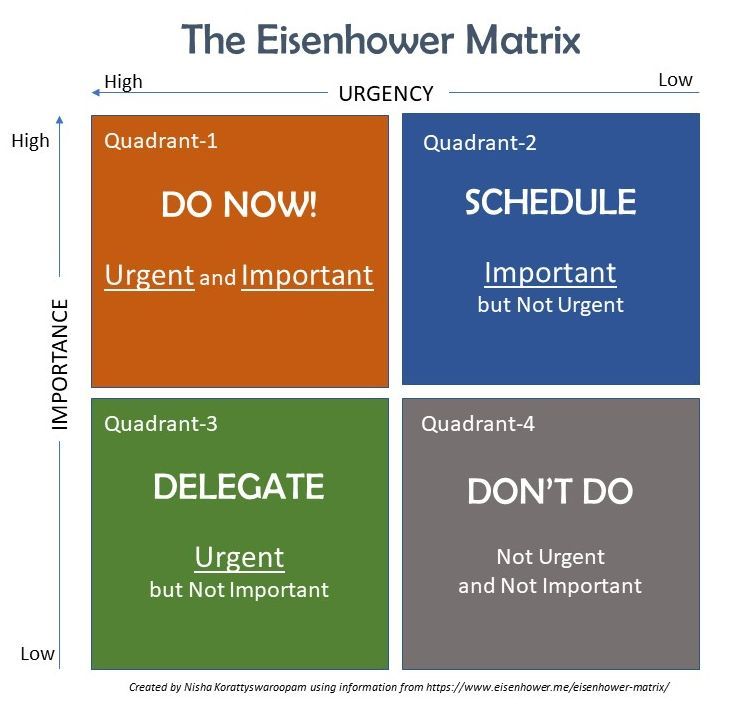
This logo isn't an ad or affiliate link. It's an organization that shares in our mission, and empowered the authors to share their insights in Byte form.
Rumie vets Bytes for compliance with our
Standards.
The organization is responsible for the completeness and reliability of the content.
Learn more
about how Rumie works with partners.
Yay!! Your team has been assigned the coveted project and everyone is very excited!
But now you're overwhelmed trying to organize all the tasksyour team needs to do to complete it on time.

Don’t panic! Use the Eisenhower Matrix to manage the project in an organized and efficient way.
What is Eisenhower Matrix?
Get Ready: Make a List
Make a list of all the things your team needs to do.
Don't worry about formatting and don’t leave anything out!
 Photo by Glenn Carstens-Peters on Unsplash
Photo by Glenn Carstens-Peters on UnsplashNow use the Eisenhower Matrix to help prioritize the tasks and make sure that everything gets done on time.
Step 1: Do Now

Select all the tasks that are urgent AND important from your list and place them in the quadrant 1.
These should be tasks that have fast-approaching deadlines, making them urgent and important for your project.

Examples might be:
Prepare a presentation on scope of your project for the meeting tomorrow
Prepare a prototype of your product/project for the presentation in 2 days
Notice that these are urgent (due soon) and also important (for the success of your project).
Quiz
Mike and his team are busy working on an important product update for client. Which of the following tasks should Mike do first?
Mike should prepare for today's client meeting because it's both urgent and important.
Step 2: Schedule

Some tasks are important to do, but you don’t have to do them right now. They're not urgent.
Place them in quadrant 2, schedule these tasks, and put them on the calendar.

For example, these would be tasks like:
Team meetings to review progress, roadblocks, etc.
Team meetings to plan for the next week's tasks
Training that team members must complete
Notice that these tasks are important (for the success of your team project) but not urgent (they don't need not be done right now).
Quiz
Nikki and her team of architects are designing a new waterfront resort. Which of the following tasks should Nikki schedule for later?
Nikki should schedule the "learn new drafting software" task for later, because while it's an important task, it's not urgent and need not be completed today.
Step 3: Delegate

Some tasks are urgent and have to be done now, but you don't have to do them yourself because they're not super important and can be done by anyone. Place them in quadrant 3 and delegate them.

Examples of tasks that can be delegated are:
Replying to a vendor email about confirming the delivery date
Picking up a cake for a colleague's birthday
Researching the best way to get a meeting in another town
Notice that these tasks are urgent and have to be done now, but it's not important that you do them yourself.
Quiz
Raj and team are working on designing a new robotic arm. Which of the following tasks should Raj delegate to someone else?
Reserving a taxi to go to a client meeting is urgent and has to be done now, but it's not an important task that Raj has to do himself. It can be delegated to someone else like a travel agent or assistant.
Step 4: Don't Do

These tasks from your list belong in quadrant 4 and should be deleted or ignored.
They're not important and not urgent.They're just a waste of time at this point.

Examples of quadrant 4 tasks:
Rearranging the office
Browsing social media for ideas about organizing the office kitchen
Scheduling a coffee chat with your teammates to discuss last week's football/hockey games
Notice that these activities are neither urgent nor important.
Quiz
Alyssa and her team are working on updating the software for a big client's billing system. Which of these tasks should Alyssa delete from her list?
Browsing social media is neither urgent nor important, even if Alyssa needs team T-shirt ideas. This task should be deleted from her list.
Take Action
Plan and organize your team project using Eisenhower Matrix!

This Byte has been authored by
Nisha Korattyswaroopam
Instructional designer I Educator I
PhD
 Listen to a description of the Eisenhower matrix.
Listen to a description of the Eisenhower matrix.